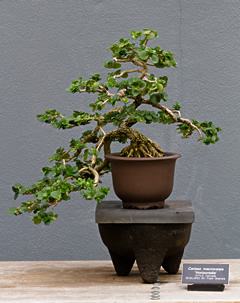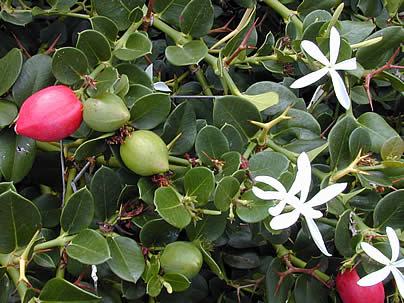The Natal Plum (Carissa macrocarpa) is a dense, evergreen, fruit-bearing shrub native to the KwaZulu-Natal province on the east coast of South Africa. It can grow to about 6 meters in height, forming a small tree, although most cultivated plants do not exceed two meters, maintaining a shrubby size. The branches are woody, densely branched, and thorny, with characteristic forked or “Y”-shaped thorns. When cut, the branches reveal a milky sap.
The leaves are ovate, dark green, glossy, with a leathery texture, and opposite. In climates with more distinct seasons (temperate and subtropical), it flowers in spring and summer, but in more tropical regions, it tends to bloom throughout the year. The flowers are white to pink, pentamerous, with waxy petals, and have a delightful aroma reminiscent of orange blossom and jasmine, becoming more intense at night. They are attractive to butterflies.

The ensuing fruits are fleshy, sweet, and juicy berries, with red skin and pulp. The taste is said to resemble strawberries and cranberries. They are rich in Vitamin C, magnesium, and phosphorus and can be consumed fresh or in the form of juices, jellies, and as dried fruits. Among the various cultivars, we can mention “Variegata”, with variegated white and cream leaves, “Nana”, “Boxwood Beauty” and “Bonsai”, of dwarf stature, and “Horizontalis” and “Prostrata”, with creeping foliage.
In the garden, the Natal Plum combines the main qualities of the perfect shrub for living fences. Besides tolerating training pruning, it is very easy to maintain in a particular shape. It has dense foliage and thorns that provide privacy and deter intruders. Finally, it graces us with fragrant flowers and fruits practically all year round. It is low maintenance, consisting of pruning and biannual fertilization.

It can be used alone, in groups, or rows. For creating defensive hedges, it is recommended to plant at a spacing of one meter. The dwarf and creeping varieties are suitable for use as ground cover or borders. However, care should be taken with sucker branches that, if not pruned, can revert to the species’ characteristics. Avoid planting Natal Plum in pedestrian traffic areas, such as walkways, as the thorns can injure passersby. It can be planted in pots and planters. It is also well-suited for bonsai art, especially the “Bonsai” and “Horizontalis” varieties.
The Natal Plum should be grown in full sun or partial shade, in any type of soil, preferably well-drained, enriched with organic matter, and watered regularly during the first years of establishment. After full establishment, the plant becomes tolerant of short periods of drought. Although it grows in partial shade conditions, it only forms dense shrubs and produces an abundance of flowers and fruits in full sun.
In partial shade, it is best grown as an informal shrub or even a small tree, as its branching becomes more sparse. It is highly adapted to saline conditions, making it successful in coastal gardens. It withstands cold and light frosts typical of subtropical climates. It is propagated by seeds, but mainly by cuttings of the branches, thus preserving the characteristics of the mother cultivar.


